Wearable Smart Textiles for Long-Term Electrocardiography Monitoring—A Review
Abstract
1. Introduction
2. Overview of the ECG Signal
3. ECG Electrodes Results
4. Textile-Based ECG Electrodes
4.1. Metal Integrated Textile Electrodes
4.2. Carbon-Coated Textile Electrodes
4.3. Conductive Polymer-Coated Textile Electrodes
5. Textile Electrodes in Veterinary ECG Monitoring
6. Design Aspects
7. Future Research and Directions
8. Conclusions
Author Contributions
Funding
Conflicts of Interest
References
- Tao, X. Smart technology for textiles and clothing—Introduction and overview. In Smart Fibres, Fabrics and Clothing; Woodhead Publishing: Cambridge, UK, 2001; pp. 1–6. ISBN 0849311721. [Google Scholar]
- Koncar, V. Introduction to smart textiles and their applications. In Smart Textiles and Their Applications; Koncar, V., Ed.; Woodhead Publishing: Cambridge, UK, 2016; pp. 1–8. ISBN 978-0-08-100583-5. [Google Scholar]
- Stoppa, M.; Chiolerio, A. Wearable Electronics and Smart Textiles: A Critical Review. Sensors 2014, 14, 11957–11992. [Google Scholar] [CrossRef]
- Lee, Y.-D.; Chung, W.-Y. Wireless Sensor Network Based Wearable Smart Shirt for Ubiquitous Health and Activity Monitoring. Sens. Actuators B Chem. 2009, 140, 390–395. [Google Scholar] [CrossRef]
- Wang, Y.; Deepu, C.J.; Lian, Y. A Computationally Efficient QRS Detection Algorithm for Wearable ECG Sensors. In Proceedings of the Annual International Conference of the IEEE Engineering in Medicine and Biology Society, EMBS, Boston, MA, USA, 30 August–3 September 2011; pp. 5641–5644. [Google Scholar] [CrossRef]
- Das, S.C.; Chowdhury, N. Smart Textiles—New Possibilities in Textile Engineering. IOSR J. Polym. Text. Eng. 2014, 1, 1–3. [Google Scholar]
- Sun, F.; Yi, C.; Li, W.; Li, Y. A Wearable H-Shirt for Exercise ECG Monitoring and Individual Lactate Threshold Computing. Comput. Ind. 2017, 92, 1–11. [Google Scholar] [CrossRef]
- Patel, S.; Park, H.; Bonato, P.; Chan, L.; Rodgers, M. A Review of Wearable Sensors and Systems with Application in Rehabilitation. J. Neuroeng. Rehabil. 2012, 9, 1–17. [Google Scholar] [CrossRef] [PubMed]
- Drean, E.; Schacher, L.; Adolphe, D.; Bauer, F. Smart Textiles for Automotive: Application to Airbag Development. Exp. Tech. 2008, 32, 44–48. [Google Scholar] [CrossRef]
- Scataglini, S.; Andreoni, G.; Gallant, J. Smart Clothing Design Issues in Military Applications. In Proceedings of the International Conference on Applied Human Factors and Ergonomics; Springer: New York, NY, USA, 24 June 2018; pp. 158–168. [Google Scholar]
- Pani, D.; Achilli, A.; Bonfiglio, A. Survey on Textile Electrode Technologies for Electrocardiographic (ECG) Monitoring, from Metal Wires to Polymers. Adv. Mater. Technol. 2018, 3, 1800008. [Google Scholar] [CrossRef]
- Murphy, M.A.; Bergquist, F.; Hagström, B.; Hernández, N.; Johansson, D.; Ohlsson, F.; Sandsjö, L.; Wipenmyr, J.; Malmgren, K. An Upper Body Garment with Integrated Sensors for People with Neurological Disorders—Early Development and Evaluation. BMC Biomed. Eng. 2019, 3, 1–13. [Google Scholar] [CrossRef] [PubMed]
- Pola, T.; Vanhala, J. Textile Electrodes in ECG Measurement. In Proceedings of the IEEE 2007 3rd International Conference on Intelligent Sensors, Sensor Networks and Information, Melbourne, Australia, 3–6 December 2007; pp. 635–639. [Google Scholar]
- Löfhede, J.; Seoane, F.; Thordstein, M. Textile Electrodes for EEG Recording—A Pilot Study. Sensors 2012, 12, 16907–16919. [Google Scholar] [CrossRef] [PubMed]
- Shafti, A.; Manero, R.B.R.; Borg, A.M.; Althoefer, K.; Howard, M.J. Designing Embroidered Electrodes for Wearable Surface Electromyography. In Proceedings of the IEEE International Conference on Robotics and Automation (ICRA), Stockholm, Sweden, 16–21 May 2016. [Google Scholar]
- Sibinski, M.; Jakubowska, M.; Sloma, M. Flexible Temperature Sensors on Fibers. Sensors 2010, 10, 7934–7946. [Google Scholar] [CrossRef]
- Min, S.D.; Yun, Y.; Shin, H. Simplified Structural Textile Respiration Sensor Based on Capacitive Pressure Sensing Method. IEEE Sens. J. 2014, 14, 3245–3251. [Google Scholar] [CrossRef]
- Paradiso, R.; Loriga, G.; Taccini, N.; Gemignani, A.; Ghelarducci, B. A Wearable Healthcare System: New Frontier on e-Textile. J. Telecommun. Inf. Technol. 2005, 4, 105–113. [Google Scholar]
- Salvo, P.; Di Francesco, F.; Costanzo, D.; Ferrari, C.; Trivella, M.G.; de Rossi, D.; Theory, A. A Wearable Sensor for Measuring Sweat Rate. IEEE Sens. J. 2010, 10, 1557–1558. [Google Scholar] [CrossRef]
- Lee, J.W.; Yun, K.S. ECG Monitoring Garment Using Conductive Carbon Paste for Reduced Motion Artifacts. Polymers 2017, 9, 439. [Google Scholar] [CrossRef]
- Ramasamy, S.; Balan, A. Wearable Sensors for ECG Measurement: A Review. Sens. Rev. 2018, 38, 412–419. [Google Scholar] [CrossRef]
- Penhaker, M.; Polomik, J.; Kubicek, J.; Kasik, V. Biopotential Conducting Polymer Electrodes Design and Realization for ECG Measurement. In Proceedings of the 10th International Joint Conference on Biomedical Engineering Systems and Technologies (BIOSTEC 2017), Porto, Portugal, 21–23 February 2017; pp. 134–141. [Google Scholar]
- Takamatsu, S.; Lonjaret, T.; Crisp, D.; Badier, J. Direct Patterning of Organic Conductors on Knitted Textiles for Long-Term Electrocardiography. Nat. Publ. Group 2015, 1–7. [Google Scholar] [CrossRef] [PubMed]
- Ankhili, A.; Tao, X.; Cochrane, C.; Coulon, D.; Koncar, V. Washable and Reliable Textile Electrodes Embedded into Underwear Fabric for Electrocardiography (ECG) Monitoring. Materials 2018, 11, 256. [Google Scholar] [CrossRef]
- Lou, C.; Li, R.; Li, Z.; Liang, T.; Wei, Z.; Run, M.; Yan, X.; Liu, X. Flexible Graphene Electrodes for Prolonged Dynamic ECG Monitoring. Sensors 2016, 16, 1833. [Google Scholar] [CrossRef] [PubMed]
- Nemati, E.; Deen, M.J.; Mondal, T. A Wireless Wearable ECG Sensor for Long-Term Applications. IEEE Commun. Mag. 2012, 50, 36–43. [Google Scholar] [CrossRef]
- Neuman, M.R. Biopotential electrodes. In Medical Instrumentation Application and Design; Webster, J.G., Ed.; John Wiley & Sons: Hoboken, NJ, USA, 2010; pp. 126–215. [Google Scholar]
- Weinhaus, A.J.; Kenneth, P. Roberts Anatomy of the Human Heart. In Handbook of Cardiac Anatomy, Physiology, and Devices; Iaizzo, P.A., Ed.; Humana Press Inc.: Totowa, NJ, USA, 2005; pp. 51–79. ISBN 9788578110796. [Google Scholar]
- Taji, B.; Shirmohammadi, S.; Groza, V.; Bolic, M. An ECG Monitoring System Using Conductive Fabric. In Proceedings of the 2013 IEEE International Symposium on Medical Measurements and Applications (MeMeA), Gatineau, QC, Canada, 4–5 May 2013; pp. 309–314. [Google Scholar] [CrossRef]
- Fleury, A.; Sugar, M.; Chau, T.; Bloorview, H.; Rehabilitation, K.; Alomainy, A.; Timmons, N. E-Textiles in Clinical Rehabilitation: A Scoping Review. Electronics 2015, 4, 173–203. [Google Scholar] [CrossRef]
- De Capua, C.; Meduri, A.; Morello, R. A Smart ECG Measurement System Based on Web-Service-Oriented Architecture for Telemedicine Applications. IEEE Trans. Instrum. Meas. 2010, 59, 2530–2538. [Google Scholar] [CrossRef]
- Hadjem, M.; Salem, O.; Nait-Abdesselam, F. An ECG Monitoring System for Prediction of Cardiac Anomalies Using WBAN. In Proceedings of the 2014 IEEE 16th International Conference on e-Health Networking, Applications and Services (Healthcom), Natal, Brazil, 15–18 October 2014; pp. 441–446. [Google Scholar] [CrossRef]
- Yu, Y.; Zhang, J.; Liu, J. Biomedical Implementation of Liquid Metal Ink as Drawable ECG Electrode and Skin Circuit. PLoS ONE 2013, 8, e0058771. [Google Scholar] [CrossRef]
- Ribeiro, D.M.D.; Fu, L.S.; Carlós, L.A.D.; Cunha, J.P.S. A Novel Dry Active Biosignal Electrode Based on an Hybrid Organic-Inorganic Interface Material. IEEE Sens. J. 2011, 11, 2241–2245. [Google Scholar] [CrossRef]
- Dupre, A.; Sarah Vincent, S.; Paul, A. Iaizzo Basic ECG theory, Recordings, and interpretation. In Handbook of Cardiac Anatomy, Physiology, and Devices; Humana Press: Totowa, NJ, USA, 2005; ISBN 978-1-59259-835-9. [Google Scholar]
- Gonzales, L.; Walker, K.; Keller, K.; Beckman, D.; Goodell, H.; Wright, G.; Rhone, C.; Emery, A.; Wright, G.; Rhone, C. Textile Sensor System for Electrocardiogram Monitoring. In Proceedings of the IEEE Virtual Conference on Applications of Commercial Sensors (VCACS), Raleigh, NC, USA, 15 March–15 October 2015; pp. 5–8. [Google Scholar]
- Beckmann, L. Characterization of Textile Electrodes and Conductors Using Standardized Measurement Setups. Physiol. Meas. 2010, 31, 233–247. [Google Scholar] [CrossRef]
- Taji, B. Reconstruction of ECG Signals Acquired with Conductive Textile Electrodes; University of Ottawa: Ottawa, ON, Canada, 2013. [Google Scholar]
- Yapici, M.K.; Alkhidir, T.E. Intelligent Medical Garments with Graphene-Functionalized Smart-Cloth ECG Sensors. Sensors 2017, 17, 875. [Google Scholar] [CrossRef] [PubMed]
- Khairuddin, A.M.; Ku Azir, K.N.F.; Eh Kan, P. Design and Development of Intelligent Electrodes for Future Digital Health Monitoring: A Review. IOP Conf. Ser. Mater. Sci. Eng. 2018, 318. [Google Scholar] [CrossRef]
- Xu, P.J.; Zhang, H.; Tao, X.M. Textile-Structured Electrodes for Electrocardiogram. Text. Prog. 2008, 40, 183–213. [Google Scholar] [CrossRef]
- Abu-Saude, M.; Morshed, B.I. Characterization of a Novel Polypyrrole (PPy) Conductive Polymer Coated Patterned Vertical CNT (PvCNT) Dry ECG Electrode. Chemosensors 2018, 6, 27. [Google Scholar] [CrossRef]
- Miao, F.; Cheng, Y.; He, Y.; He, Q.; Li, Y. A Wearable Context-Aware ECG Monitoring System Integrated with Built-in Kinematic Sensors of the Smartphone. Sensors 2015, 15, 11465–11484. [Google Scholar] [CrossRef] [PubMed]
- Kumar, N.M.; Thilagavathi, G. Design and Development of Textile Electrodes for EEG Measurement Using Copper Plated Polyester Fabrics. J. Text. Appar. Technol. Manag. 2018, 8, 1–8. [Google Scholar]
- Merritt, C.R.; Nagle, H.T.; Grant, E.; Member, S. Fabric-Based Active Electrode Design and Fabrication for Health Monitoring Clothing. IEEE Trans. Inf. Technol. Biomed. 2009, 13, 274–280. [Google Scholar] [CrossRef] [PubMed]
- Meziane, N.; Webster, J.G.; Attari, M.; Nimunkar, A.J. Dry Electrodes for Electrocardiography. Physiol. Meas. 2013, 34, R47–R69. [Google Scholar] [CrossRef] [PubMed]
- Albulbul, A. Evaluating Major Electrode Types for Idle Biological Signal Measurements for Modern Medical Technology. Bioengineering 2016, 3, 20. [Google Scholar] [CrossRef] [PubMed]
- Liu, Y.; Li, X.; Lu, J.C. Electrically Conductive Poly (3, 4-Ethylenedioxythiophene)–Polystyrene Sulfonic Acid/Polyacrylonitrile Composite Fibers Prepared by Wet Spinning. J. Appl. Polym. Sci. 2013, 370–374. [Google Scholar] [CrossRef]
- Jung, H.C.; Moon, J.H.; Baek, D.H.; Lee, J.H.; Choi, Y.Y.; Hong, J.S.; Lee, S.H. CNT/PDMS Composite Flexible Dry Electrodesfor Long-Term ECG Monitoring. IEEE Trans. Biomed. Eng. 2012, 59, 1472–1479. [Google Scholar] [CrossRef] [PubMed]
- Chen, Y.H.; de Op Beeck, M.; Vanderheyden, L.; Carrette, E.; Mihajlović, V.; Vanstreels, K.; Grundlehner, B.; Gadeyne, S.; Boon, P.; van Hoof, C. Soft, Comfortable Polymer Dry Electrodes for High Quality ECG and EEG Recording. Sensors 2014, 14, 23758–23780. [Google Scholar] [CrossRef]
- Chen, W.; Oetomo, S.B.; Feijs, L.; Bouwstra, S. Design of an Integrated Sensor Platform for Vital Sign Monitoring of Newborn Infants at Neonatal Intensive Care Unit. J. Healthc. Eng. 2010, 1, 535–554. [Google Scholar] [CrossRef]
- Lage, J.; Catarino, A.; Carvalho, H.; Rocha, A. Smart Shirt with Embedded Vital Sign and Moisture Sensing. In Proceedings of the 1st International Conference on Smart Portable, Wearable, Implantable and Disability-Oriented Devices and Systems, Brussels, Belgium, 21–26 June 2015; pp. 25–30. [Google Scholar]
- Song, H.Y.; Lee, J.H.; Kang, D.; Cho, H.; Cho, H.S.; Lee, J.W.; Lee, Y.J. Textile Electrodes of Jacquard Woven Fabrics for Biosignal Measurement. J. Text. Inst. 2010, 101, 758–770. [Google Scholar] [CrossRef]
- Pragya, A.; Singh, H.; Kumar, B.; Gupta, H.; Shankar, P. Designing and Investigation of Braided-Cum-Woven Structure for Wearable Heating Textile Designing and Investigation of Braided-Cum-Woven Structure for Wearable Heating Textile. Eng. Res. Express 2020, 2, 015003. [Google Scholar] [CrossRef]
- Liu, Y.; Zhao, X.; Tuo, X. Preparation of Polypyrrole Coated Cotton Conductive Fabrics. J. Text. Inst. 2017, 5000. [Google Scholar] [CrossRef]
- Kazani, I.; Hertleer, C.; de Mey, G.; Schwarz, A.; Guxho, G.; Langenhove, L.v. Electrical Conductive Textiles Obtained by Screen Printing. Fibres Text. East. Eur. 2012, 90, 57–63. [Google Scholar]
- Shateri-khalilabad, M.; Yazdanshenas, M.E.; Etemadifar, A. Fabricating Multifunctional Silver Nanoparticles-Coated Cotton Fabric. Arab. J. Chem. 2017, 10, 2355–2362. [Google Scholar] [CrossRef]
- Tseghai, G.B.; Mengistie, D.A.; Malengier, B.; Fante, K.A.; Langenhove, L.v. PEDOT: PSS-Based Conductive Textiles and Their Applications. Sensors 2020, 20, 1881. [Google Scholar] [CrossRef] [PubMed]
- Vojtech, L.; Bortel, R.; Neruda, M.; Kozak, M. Wearable Textile Electrodes for ECG Measurement. Adv. Electr. Electron. Eng. 2013, 11, 410–414. [Google Scholar] [CrossRef]
- Das, P.S.; Kim, J.W.; Park, J.Y. Fashionable Wrist Band Using Highly Conductive Fabric for Electrocardiogram Signal Monitoring. J. Ind. Text. 2019, 49, 243–261. [Google Scholar] [CrossRef]
- Linz, T.; Gourmelon, L.; Langereis, G. Contactless EMG Sensors Embroidered onto Textile. In Proceedings of the 4th International Workshop on Wearable and Implantable Body Sensor Networks (BSN 2007); Leonhardt, S., Falck, T., Mähönen, P., Eds.; Springer: Berlin/Heidelberg, Germany, 2007; Volume 13, pp. 29–34. [Google Scholar]
- Pantelopoulos, A.; Bourbakis, N.G. A Survey OnWearable Sensor-Based Systems for Health Monitoring and Prognosis. IEEE Trans. Syst. Man Cybern. Appl. Rev. 2010, 40, 1–12. [Google Scholar] [CrossRef]
- Yapici, M.K.; Alkhidir, T.; Samad, Y.A.; Liao, K. Graphene-Clad Textile Electrodes for Electrocardiogram Monitoring. Sens. Actuators B Chem. 2015, 221, 1469–1474. [Google Scholar] [CrossRef]
- Sun, Y.; Yu, X. Capacitive Biopotential Measurement for Electrophysiological Signal Acquisition: A Review. IEEE Sens. J. 2016, 16, 2832–2853. [Google Scholar] [CrossRef]
- Chamadiya, B.; Mankodiya, K.; Wagner, M.; Hofmann, U.G. Textile-Based, Contactless ECG Monitoring for Non-ICU Clinical Settings. J. Ambient. Intell. Humaniz. Comput. 2013, 4, 791–800. [Google Scholar] [CrossRef]
- Li, H.; Chen, X.; Cao, L.; Zhang, C.; Tang, C.; Li, E.; Feng, X.; Liang, H. Textile-Based ECG Acquisition System with Capacitively Coupled Electrodes. Trans. Inst. Meas. Control. 2017, 39, 141–148. [Google Scholar] [CrossRef]
- Lee, J.S.; Heo, J.; Lee, W.K.; Lim, Y.G.; Kim, Y.H.; Park, K.S. Flexible Capacitive Electrodes for Minimizing Motion Artifacts in Ambulatory Electrocardiograms. Sensors 2014, 14, 14732–14743. [Google Scholar] [CrossRef]
- Fuhrhop, S.; Lamparth, S.; Heuer, S. A Textile Integrated Long-Term ECG Monitor with Capacitively Coupled Electrodes. In Proceedings of the 2009 IEEE Biomedical Circuits and Systems Conference, Beijing, China, 26–28 November 2009; pp. 21–24. [Google Scholar] [CrossRef]
- Babusiak, B.; Borik, S.; Balogova, L. Textile Electrodes in Capacitive Signal Sensing Applications. Meas. J. Int. Meas. Confed. 2018, 114, 69–77. [Google Scholar] [CrossRef]
- Lim, Y.G.; Kim, K.K.; Park, K.S. ECG Measurement on a Chair without Conductive Contact. IEEE Trans. Biomed. Eng. 2006, 53, 956–959. [Google Scholar] [CrossRef]
- Lee, H.J.; Hwang, S.H.; Yoon, H.N.; Lee, W.K.; Park, K.S. Heart Rate Variability Monitoring during Sleep Based on Capacitively Coupled Textile Electrodes on a Bed. Sensors 2015, 15, 11295–11311. [Google Scholar] [CrossRef] [PubMed]
- Atallah, L.; Serteyn, A.; Meftah, M.; Schellekens, M.; Vullings, R.; Bergmans, J.W.M.; Osagiator, A.; Bambang, S. Oetomo Unobtrusive ECG Monitoring in the NICU Using a Capacitive Sensing Array. Physiol. Meas. 2014, 35, 895–913. [Google Scholar] [CrossRef] [PubMed]
- Meziane, N.; Yang, S.; Shokoueinejad, M.; Webster, J.G.; Attari, M.; Eren, H. Simultaneous Comparison of 1 Gel with 4 Dry Electrode Types for Electrocardiography. Physiol. Meas. 2015, 36, 513–529. [Google Scholar] [CrossRef] [PubMed]
- Boehm, A.; Yu, X.; Neu, W.; Leonhardt, S.; Teichmann, D. A Novel 12-Lead ECG T-Shirt with Active Electrodes. Electronics 2016, 5, 75. [Google Scholar] [CrossRef]
- Gassara, H.; Moukadem, A.; Adolphe, D.; Dieterlen, A.; Schacher, L. Smart Wheel Chair. In Smart Textile Salon; ITMC: Ghent, Belgium, 12 December 2017; Volume 6, pp. 12–13. [Google Scholar]
- Di Rienzo, M.; Rizzo, F.; Parati, G.; Brambilla, G.; Ferratini, M.; Castiglioni, P. MagIC System: A New Textile-Based Wearable Device for Biological Signal Monitoring. Applicability in Daily Life and Clinical Setting. Annu. Int. Conf. IEEE Eng. Med. Biol. Proc. 2005, 7, 7167–7169. [Google Scholar] [CrossRef]
- Di Rienzo, M.; Racca, V.; Rizzo, F.; Bordoni, B.; Parati, G.; Castiglioni, P.; Meriggi, P.; Ferratini, M. Evaluation of a Textile-Based Wearable System for the Electrocardiogram Monitoring in Cardiac Patients. Europace 2013, 15, 607–612. [Google Scholar] [CrossRef]
- Taji, B.; Chan, A.D.C.; Shirmohammadi, S. Effect of Pressure on Skin-Electrode Impedance in Wearable Biomedical Measurement Devices. IEEE Trans. Instrum. Meas. 2018, 67, 1900–1912. [Google Scholar] [CrossRef]
- Takeshita, T.; Yoshida, M.; Takei, Y.; Ouchi, A.; Hinoki, A. Relationship between Contact Pressure and Motion Artifacts in ECG Measurement with Electrostatic Flocked Electrodes Fabricated on Textile. Sci. Rep. 2019, 1–10. [Google Scholar] [CrossRef]
- Ankhili, A.; Zaman, S.; Tao, X.; Cochrane, C.; Končar, V.; Coulon, D. Washable Embroidered Textile Electrodes for Long-Term Electrocardiography Monitoring. TLR 2019, 2, 126–135. [Google Scholar] [CrossRef]
- An, X.; Stylios, G.K. A Hybrid Textile Electrode for Electrocardiogram (ECG) Measurement and Motion Tracking. Materials 2018, 11, 1887. [Google Scholar] [CrossRef] [PubMed]
- Joutsen, A.S.; Kaappa, E.S.; Karinsalo, T.J.; Vanhala, J. Dry Electrode Sizes in Recording ECG and Heart Rate in Wearable Applications. In EMBEC & NBC 2017; Springer: Singapore, 2018; Volume 65, pp. 1089–1090. [Google Scholar] [CrossRef]
- An, X.; Tangsirinaruenart, O.; Stylios, G.K. Investigating the Performance of Dry Textile Electrodes for Wearable End-Uses. J. Text. Inst. 2019, 110, 151–158. [Google Scholar] [CrossRef]
- Liu, Z.; Liu, X. Progress on Fabric Electrodes Used in ECG Signals Monitoring. J. Text. Sci. Technol. 2015, 1, 110–117. [Google Scholar] [CrossRef][Green Version]
- Inoue, M.; Tada, Y.; Muta, H.; Hayashi, Y.; Tokumaru, T. Development of Highly Conductive Inks for Smart Textiles. IEEE Sens. J. 2012, 1–4. [Google Scholar] [CrossRef]
- Tong, W.; Kan, C.; Yang, H.; Member, S. Sensitivity Analysis of Wearable Textiles for ECG Sensing. In Proceedings of the IEEE EMBS International Conference on Biomedical & Health Informatics (BHI), Las Vegas, NV, USA, 4–7 March 2018; pp. 4–7. [Google Scholar]
- Nigusse, A.B.; Malengier, B.; Mengistie, D.A.; Tseghai, G.B.; Langenhove, L.v. Development of Washable Silver Printed Textile Electrodes for Long-Term ECG Monitoring. Sensors 2020, 20, 6233. [Google Scholar] [CrossRef] [PubMed]
- Arquilla, K.; Webb, A.K.; Allison, P. Anderson Textile Electrocardiogram (ECG) Electrodes for Wearable Health Monitoring. Sensors 2020, 20, 1013. [Google Scholar] [CrossRef]
- Huang, X.; Dai, B.; Ren, Y.; Xu, J.; Zhu, P. Preparation and Study of Electromagnetic Interference Shielding Materials Comprised of Ni-Co Coated on Web-like Biocarbon Nanofibers via Electroless Deposition. J. Nanomater. 2015, 2015. [Google Scholar] [CrossRef]
- Gamage, S.J.P.; Yang, K.; Braveenth, R.; Raagulan, K.; Kim, H.S.; Lee, Y.S.; Yang, C.M.; Moon, J.J.; Chai, K.Y. MWCNT Coated Free-Standing Carbon Fiber Fabric for Enhanced Performance in EMI Shielding with a Higher Absolute EMI SE. Materials 2017, 10, 1350. [Google Scholar] [CrossRef]
- Chlaihawi, A.A.; Narakathu, B.B.; Emamian, S.; Bazuin, B.J.; Atashbar, M.Z. Development of Printed and Flexible Dry ECG Electrodes. Sens. Bio Sens. Res. 2018, 20, 9–15. [Google Scholar] [CrossRef]
- Ankhili, A.; Tao, X.; Cochrane, C.; Koncar, V.; Coulon, D.; Tarlet, J.-M. Ambulatory Evaluation of ECG Signals Obtained Using Washable Textile-Based Electrodes Made with Chemically Modified PEDOT:PSS. Sensors 2019, 19, 416. [Google Scholar] [CrossRef] [PubMed]
- Trindade, I.G.; Martins, F.; Baptista, P. High Electrical Conductance Poly(3,4-Ethylenedioxythiophene) Coatings on Textile for Electrocardiogram Monitoring. Synth. Met. 2015, 210, 179–185. [Google Scholar] [CrossRef]
- Gokarneshan, N. Some Significant Trends in Conductive Textiles. Latest Trends Text. Fash. Des. 2018, 2, 179–186. [Google Scholar] [CrossRef]
- Wattal, S.; Spear, S.K.; Imtiaz, M.H.; Sazonov, E. A Polypyrrole-Coated Textile Electrode and Connector for Wearable ECG Monitoring. In Proceedings of the 2018 IEEE 15th International Conference on Wearable and Implantable Body Sensor Networks (BSN), Las Vegas, NV, USA, 4–7 March 2018; pp. 54–57. [Google Scholar]
- Castrillón, R.; Pérez, J.J.; Andrade-Caicedo, H. Electrical Performance of PEDOT: PSS-Based Textile Electrodes for Wearable ECG Monitoring: A Comparative Study. Bio Med. Eng. Online 2018, 17, 1–23. [Google Scholar] [CrossRef]
- Achilli, A.; Pani, D.; Bonfiglio, A. Characterization of Screen-Printed Textile Electrodes Based on Conductive Polymer for ECG Acquisition. Comput. Cardiol. 2017, 44, 1–4. [Google Scholar] [CrossRef]
- Sinha, S.K.; Noh, Y.; Reljin, N.; Treich, G.M.; Hajeb-Mohammadalipour, S.; Guo, Y.; Chon, K.H.; Sotzing, G.A. Screen-Printed PEDOT:PSS Electrodes on Commercial Finished Textiles for Electrocardiography. ACS Appl. Mater. Interfaces 2017, 9, 37524–37528. [Google Scholar] [CrossRef]
- Achilli, A.; Bonfiglio, A.; Pani, D. Design and Characterization of Screen-Printed Textile Electrodes for ECG Monitoring. IEEE Sens. J. 2018, 18, 4097–4107. [Google Scholar] [CrossRef]
- Pani, D.; Achilli, A.; Bassareo, P.P.; Cugusi, L.; Mercuro, G.; Fraboni, B.; Bonfiglio, A. Fully-Textile Polymer-Based ECG Electrodes: Overcoming the Limits of Metal-Based Textiles. In Proceedings of the Computing in Cardiology 2016, Vancouver, BC, Canada, 11–14 September 2016; Volume 43, pp. 1–4. [Google Scholar]
- Pani, D.; Dessi, A.; Saenz-Cogollo, J.F.; Barabino, G.; Fraboni, B.; Bonfiglio, A. Fully Textile, PEDOT:PSS Based Electrodes for Wearable ECG Monitoring Systems. IEEE Trans. Biomed. Eng. 2016, 63, 540–549. [Google Scholar] [CrossRef] [PubMed]
- Tseng, K.C.; Lin, B.S.; de Liao, L.; Te Wang, Y.; Wang, Y.L. Development of a Wearable Mobile Electrocardiogram Monitoring System by Using Novel Dry Foam Electrodes. IEEE Syst. J. 2014, 8, 900–906. [Google Scholar] [CrossRef]
- Weder, M.; Hegemann, D.; Amberg, M.; Hess, M.; Boesel, L.F.; Abächerli, R.; Meyer, V.R.; Rossi, R.M. Embroidered Electrode with Silver/Titanium Coating for Long-Term ECG Monitoring. Sensors 2015, 15, 1750–1759. [Google Scholar] [CrossRef]
- Ankhili, A.; Tao, X.; Cochrane, C.; Koncar, V.; Coulon, D.; Tarlet, J.M. Comparative Study on Conductive Knitted Fabric Electrodes for Long-Term Electrocardiography Monitoring: Silver-Plated and PEDOT:PSS Coated Fabrics. Sensors 2018, 18, 3890. [Google Scholar] [CrossRef] [PubMed]
- Taji, B.; Shirmohammadi, S.; Groza, V.; Batkin, I. Impact of Skin-Electrode Interface on Electrocardiogram Measurements Using Conductive Textile Electrodes. IEEE Trans. Instrum. Meas. 2014, 63, 1412–1422. [Google Scholar] [CrossRef]
- Zhou, Y.; Ding, X.; Zhang, J.; Duan, Y.; Hu, J.; Yang, X. Fabrication of Conductive Fabric as Textile Electrode for ECG Monitoring. Fibers Polym. 2014, 15, 2260–2264. [Google Scholar] [CrossRef]
- Marozas, V.; Petrenas, A.; Daukantas, S.; Lukosevicius, A. A Comparison of Conductive Textile-Based and Silver/Silver Chloride Gel Electrodes in Exercise Electrocardiogram Recordings. J. Electrocardiol. 2011, 44, 189–194. [Google Scholar] [CrossRef]
- Yokus, M.A.; Jur, J.S. Fabric-Based Wearable Dry Electrodes for Body Surface Biopotential Recording. IEEE Trans. Biomed. Eng. 2016, 63, 423–430. [Google Scholar] [CrossRef]
- Kannaian, T.; Neelaveni, R.; Thilagavathi, G. Design and Development of Embroidered Textile Electrodes for Continuous Measurement of Electrocardiogram Signals. J. Ind. Text. 2013, 42, 303–318. [Google Scholar] [CrossRef]
- Zhang, H.; Tian, L.; Lu, H.; Zhou, M.; Zou, H.; Fang, P.; Yao, F.; Li, G. A Wearable 12-Lead ECG Acquisition System with Fabric Electrodes. In Proceedings of the 2017 39th Annual International Conference of the IEEE Engineering in Medicine and Biology Society (EMBC), Jeju, Korea, 11–15 July 2017; pp. 4439–4442. [Google Scholar] [CrossRef]
- Peltokangas, M.; Verho, J.; Vehkaoja, A. Unobtrusive Night-Time EKG and HRV Monitoring System. In Proceedings of the IEEE 2011 10th International Workshop on Biomedical Engineering, Kos, Greece, 5–7 October 2011; pp. 1–5. [Google Scholar]
- Goodwin, J.-K. Holter Monitoring and Cardiac Event Recording. Vet. Clin. N. Am. Small Anim. Pract. 1998, 28, 1391–1407. [Google Scholar] [CrossRef]
- Kviesulaitis, V.; Kazakevičius, T.; Zabiela, V.; Puodžiukynas, A. An Approach to 24-Hour Electrocardiogram Monitoring in Sheep Experimental Model. J. Meas. Eng. 2018, 6, 119–125. [Google Scholar] [CrossRef]
- Pace, C. How ECG Monitoring Contributes to Patient Care. Vet. Nurse 2018, 9, 216–223. [Google Scholar] [CrossRef]
- Reddy, B.S. Analysis of Base Apex Lead Electrocardiograms of Adult Buffaloes. JDVAR 2015, 2. [Google Scholar] [CrossRef]
- Verheyen, T.; Decloedt, A.; Clercq, D.D.; Deprez, P.; Sys, S.U.; van Loon, G. Electrocardiography in Horses—Part 1: How to Make a Good Recording. Vlaams Diergeneeskd. Tijdschr. 2010, 7, 331–336. [Google Scholar]
- Guidi, A.; Lanata, A.; Baragli, P.; Valenza, G.; Scilingo, E. A Wearable System for the Evaluation of the Human-Horse Interaction: A Preliminary Study. Electronics 2016, 5, 63. [Google Scholar] [CrossRef]
- Guidi, A.; Lanata, A.; Valenza, G.; Scilingo, E.P.; Baragli, P. Validation of Smart Textile Electrodes for Electrocardiogram Monitoring in Free-Moving Horses. J. Vet. Behav. 2017, 17, 19–23. [Google Scholar] [CrossRef]
- Felici, M.; Nardelli, M.; Lanatà, A.; Sgorbini, M.; Pasquale Scilingo, E.; Baragli, P. Smart Textiles Biotechnology for Electrocardiogram Monitoring in Horses during Exercise on Treadmill: Validation Tests. Equine Vet. J. 2021, 53, 373–378. [Google Scholar] [CrossRef] [PubMed]
- Lanata, A.; Guidi, A.; Baragli, P.; Valenza, G.; Scilingo, E.P. A Novel Algorithm for Movement Artifact Removal in ECG Signals Acquired from Wearable Systems Applied to Horses. PLoS ONE 2015, 10, e0140783. [Google Scholar] [CrossRef]
- Kim, S.; Leonhardt, S.; Zimmermann, N.; Kranen, P.; Kensche, D.; Müller, E.; Quix, C. Influence of Contact Pressure and Moisture on the Signal Quality of a Newly Developed Textile ECG Sensor Shirt. In Proceedings of the 2008 5th International Summer School and Symposium on Medical Devices and Biosensors, Hong Kong, China, 1–3 June 2008; pp. 256–259. [Google Scholar]
- Pani, D.; Dessi, A.; Gusai, E.; Saenz-Cogollo, J.F.; Barabino, G.; Fraboni, B.; Bonfiglio, A. Evaluation of Novel Textile Electrodes for ECG Signals Monitoring Based on PEDOT:PSS-Treated Woven Fabrics. In Proceedings of the IEEE 2015 37th Annual International Conference of the IEEE Engineering in Medicine and Biology Society (EMBC), Milan, Italy, 25–29 August 2015; pp. 3197–3200. [Google Scholar]
- Xiao, X.; Pirbhulal, S.; Dong, K.; Wu, W.; Mei, X. Performance Evaluation of Plain Weave and Honeycomb Weave Electrodes for Human ECG Monitoring. J. Sens. 2017, 2017, 1–13. [Google Scholar] [CrossRef]
- Fontana, P.; Rebeca, N.; Camenzind, M.; Boesch, M.; Baty, F.; Schoch, O.D.; Brutsche, M.H.; Rossi, R.M.; Annaheim, S. Applicability of a Textile ECG-Belt for Unattended Sleep Apnoea Monitoring in a Home Setting. Sensors 2019, 19, 3367. [Google Scholar] [CrossRef] [PubMed]
- Yoo, J.; Yoo, H. Fabric Circuit Board-Based Dry Electrode and Its Characteristics for Long-Term Physiological Signal Recording. In Proceedings of the 2011 Annual International Conference of the IEEE Engineering in Medicine and Biology Society, Boston, MA, USA, 30 August–3 September 2011; pp. 2497–2500. [Google Scholar] [CrossRef]
- Taji, B.; Shirmohammadi, S.; Groza, V. Measuring Skin-Electrode Impedance Variation of Conductive Textile Electrodes under Pressure. In Proceedings of the 2014 IEEE International Instrumentation and Measurement Technology Conference (I2MTC) Proceedings, Montevideo, Uruguay, 12–15 May 2014. [Google Scholar] [CrossRef]
- Tetsuou, Y.; Miwa, T.; Hiroshige, T.; Yasuhiro, M.; Yodogawa, K. Validation of Wearable Textile Electrodes for ECG Monitoring. Heart Vessel. 2019, 34, 1203–1211. [Google Scholar] [CrossRef]
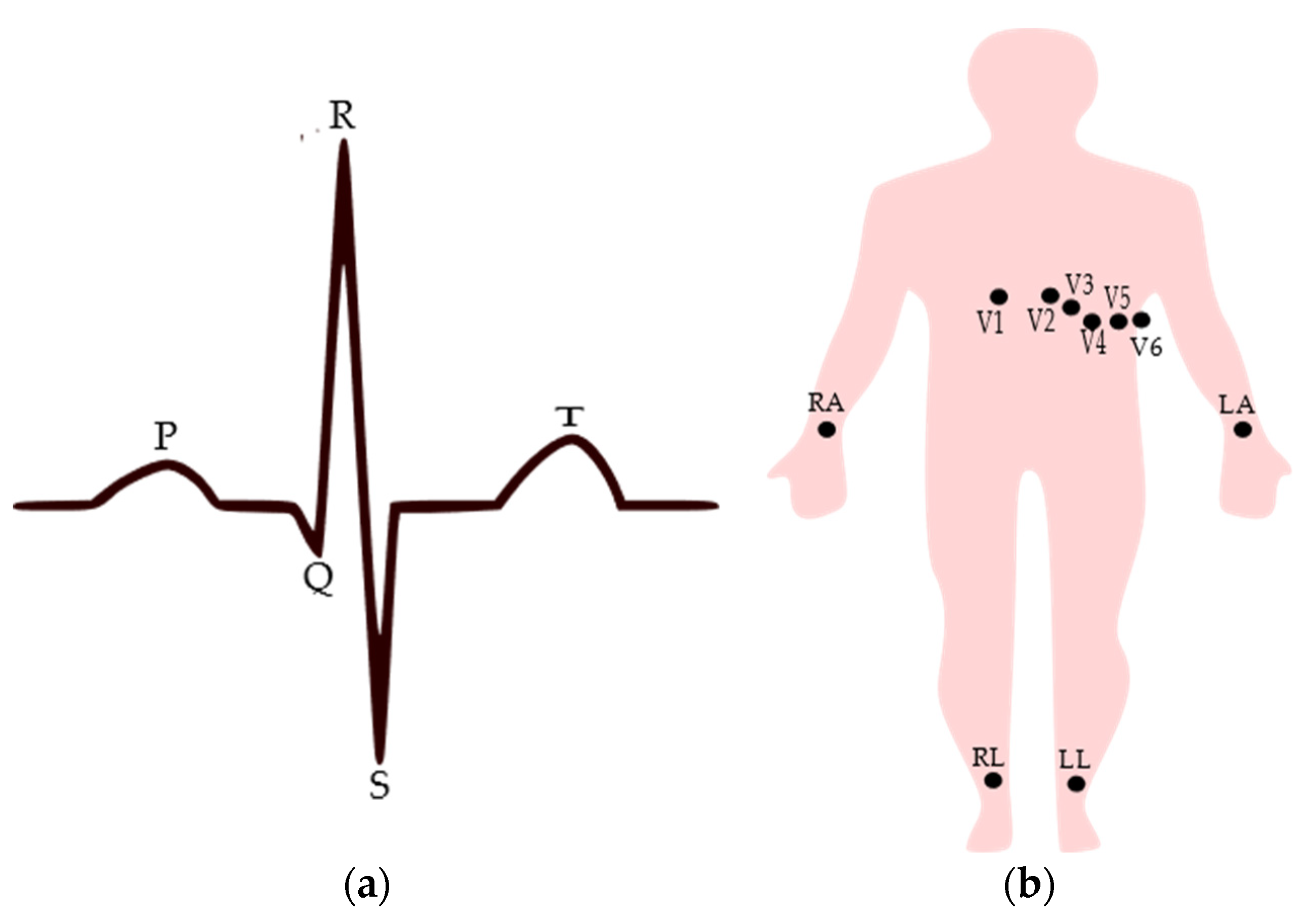
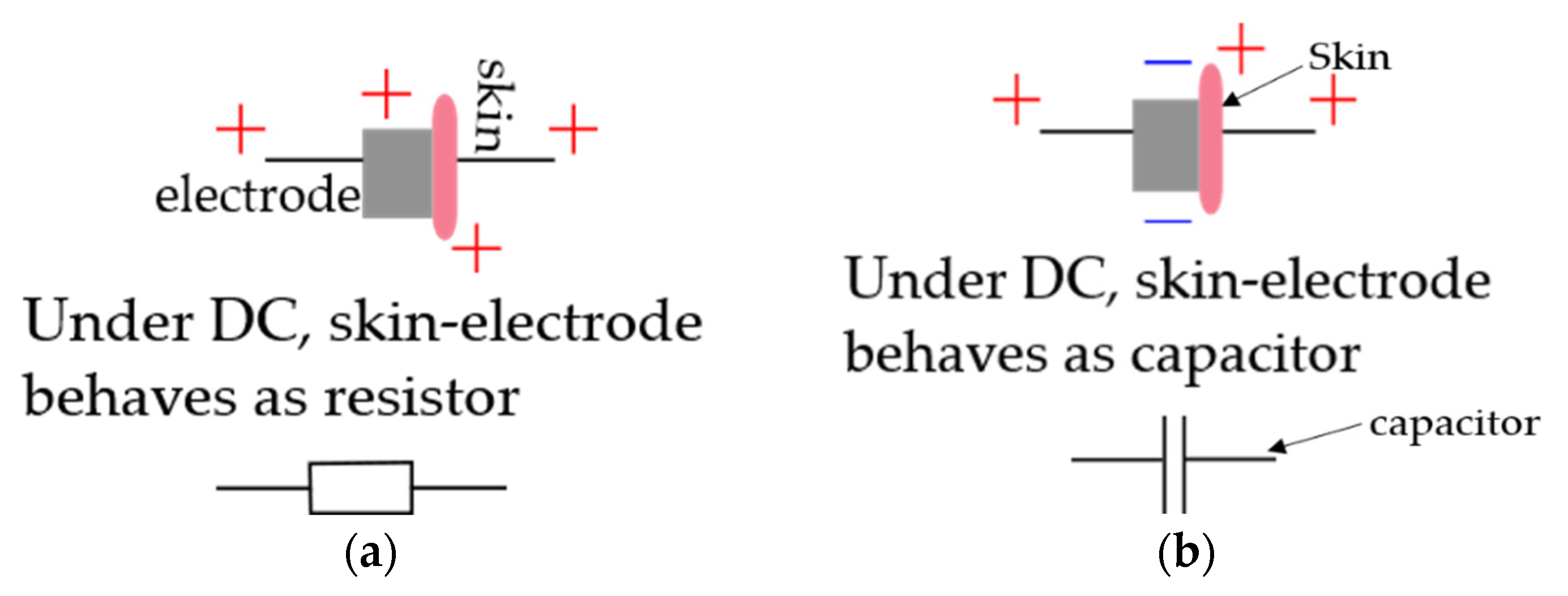

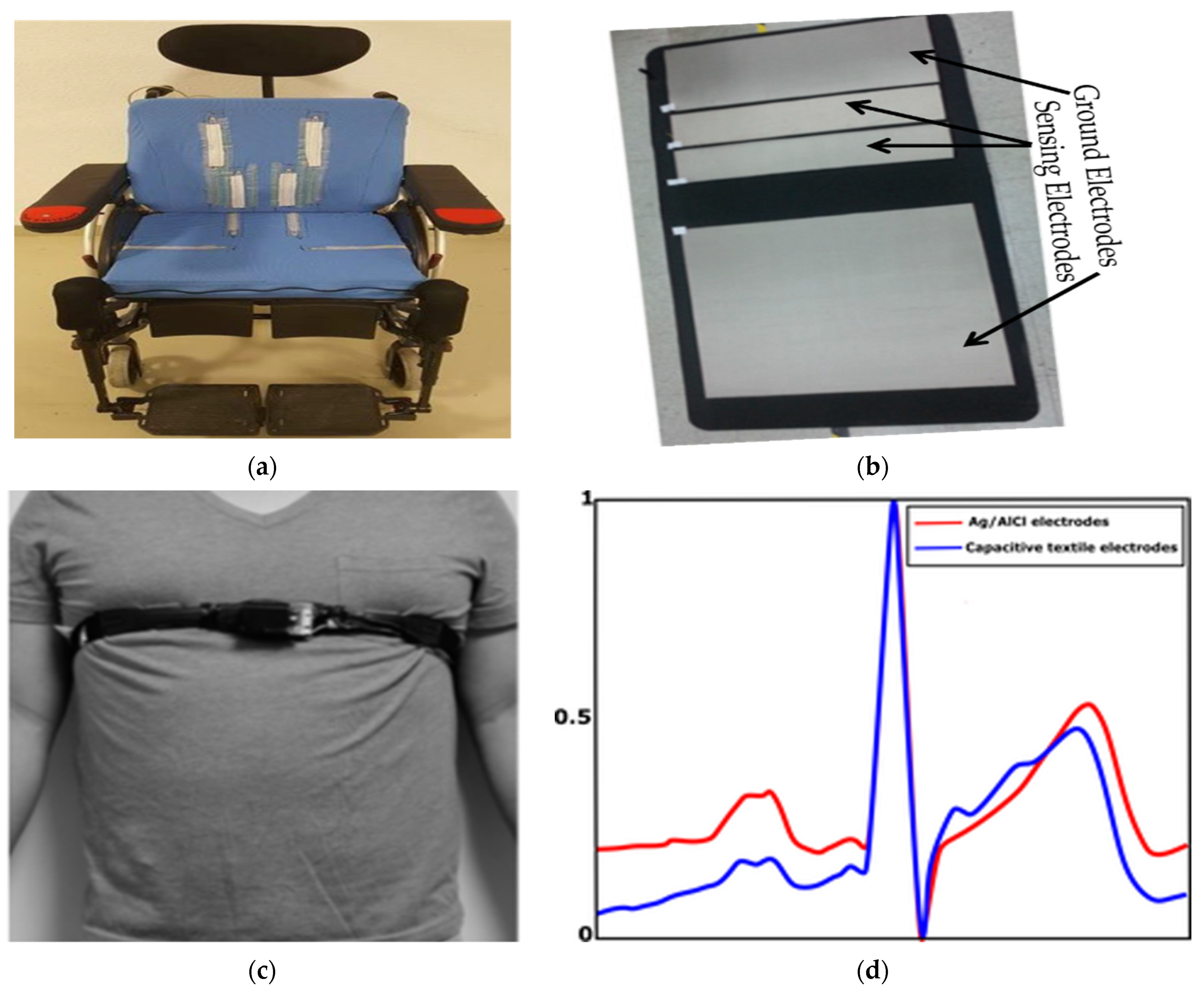
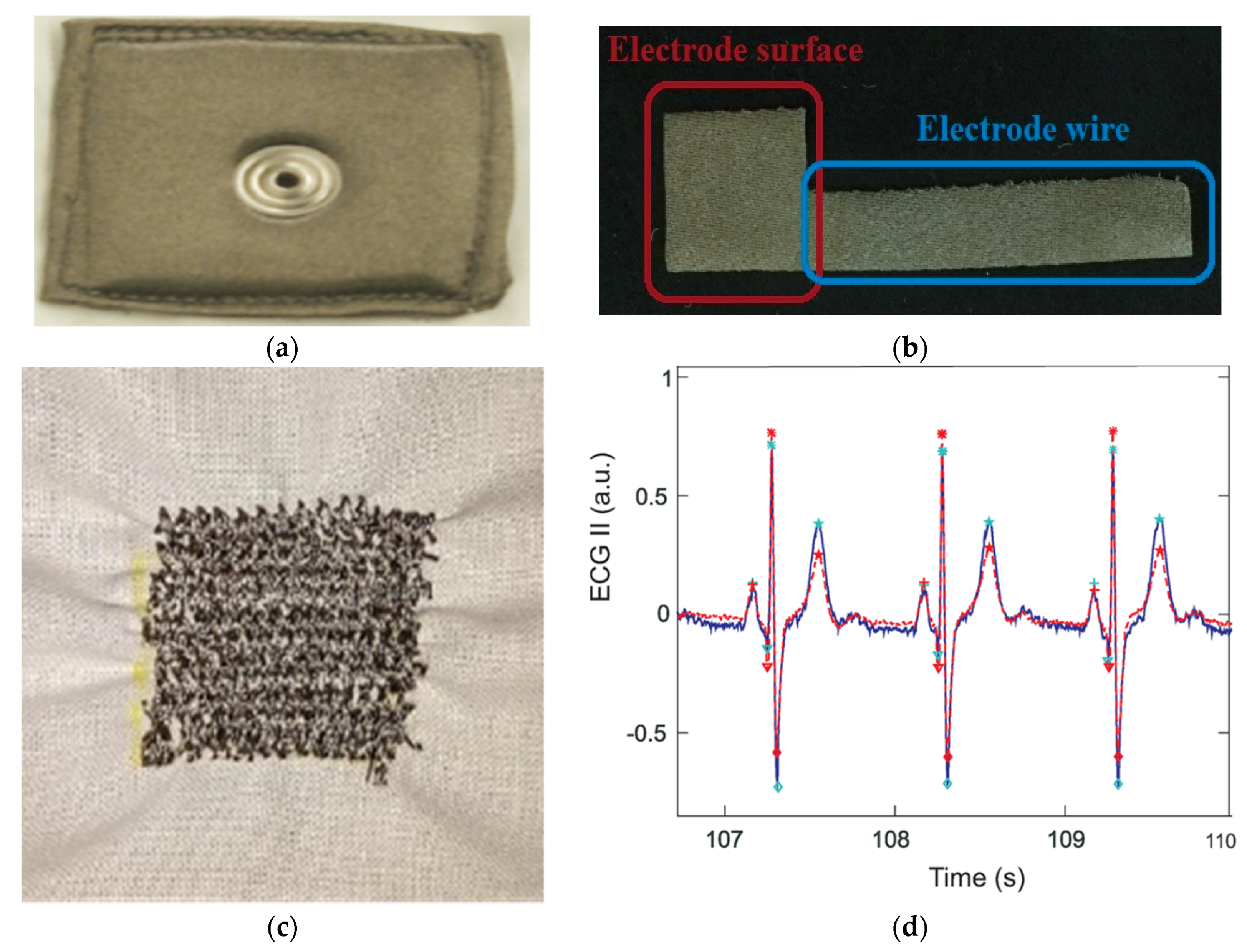

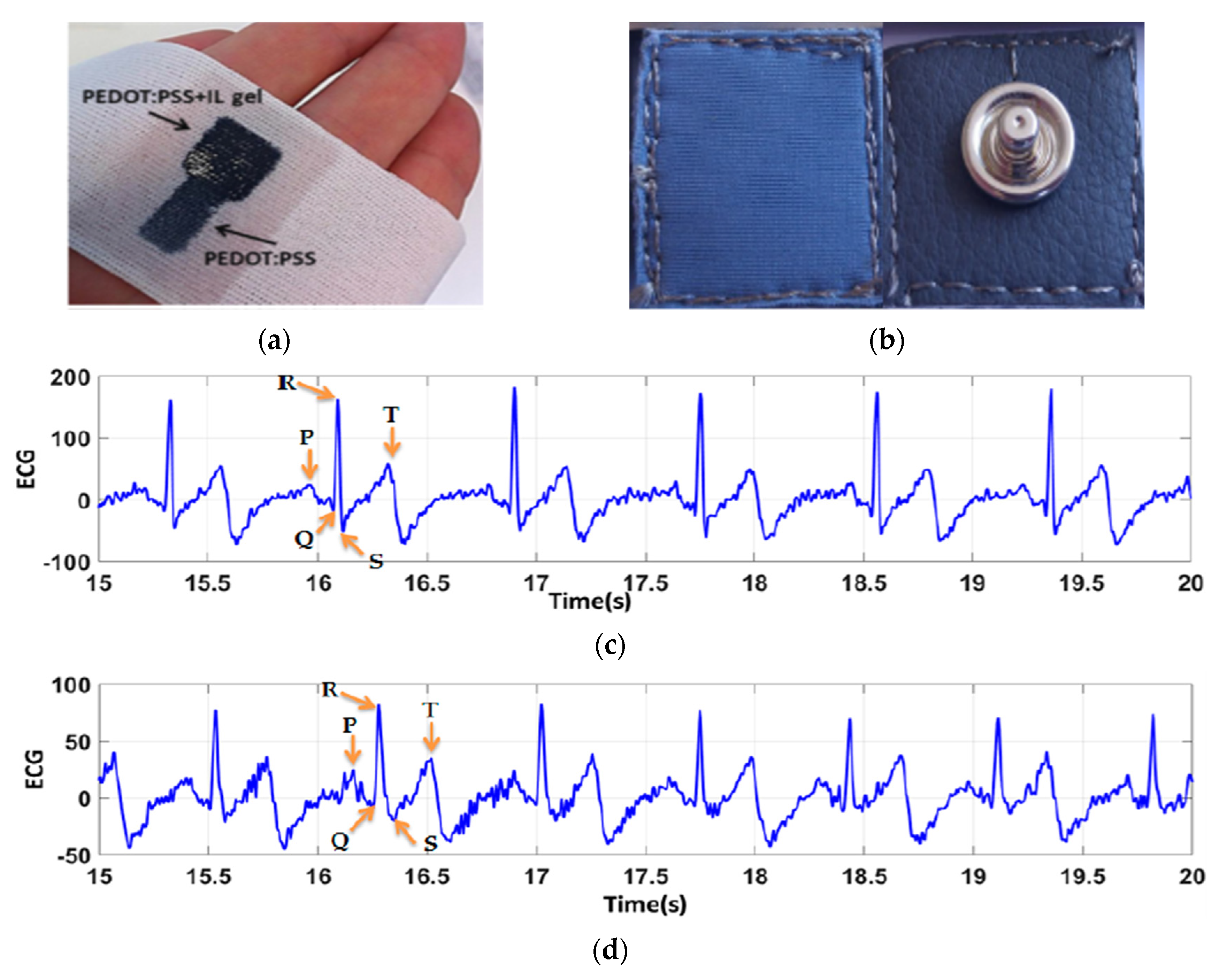
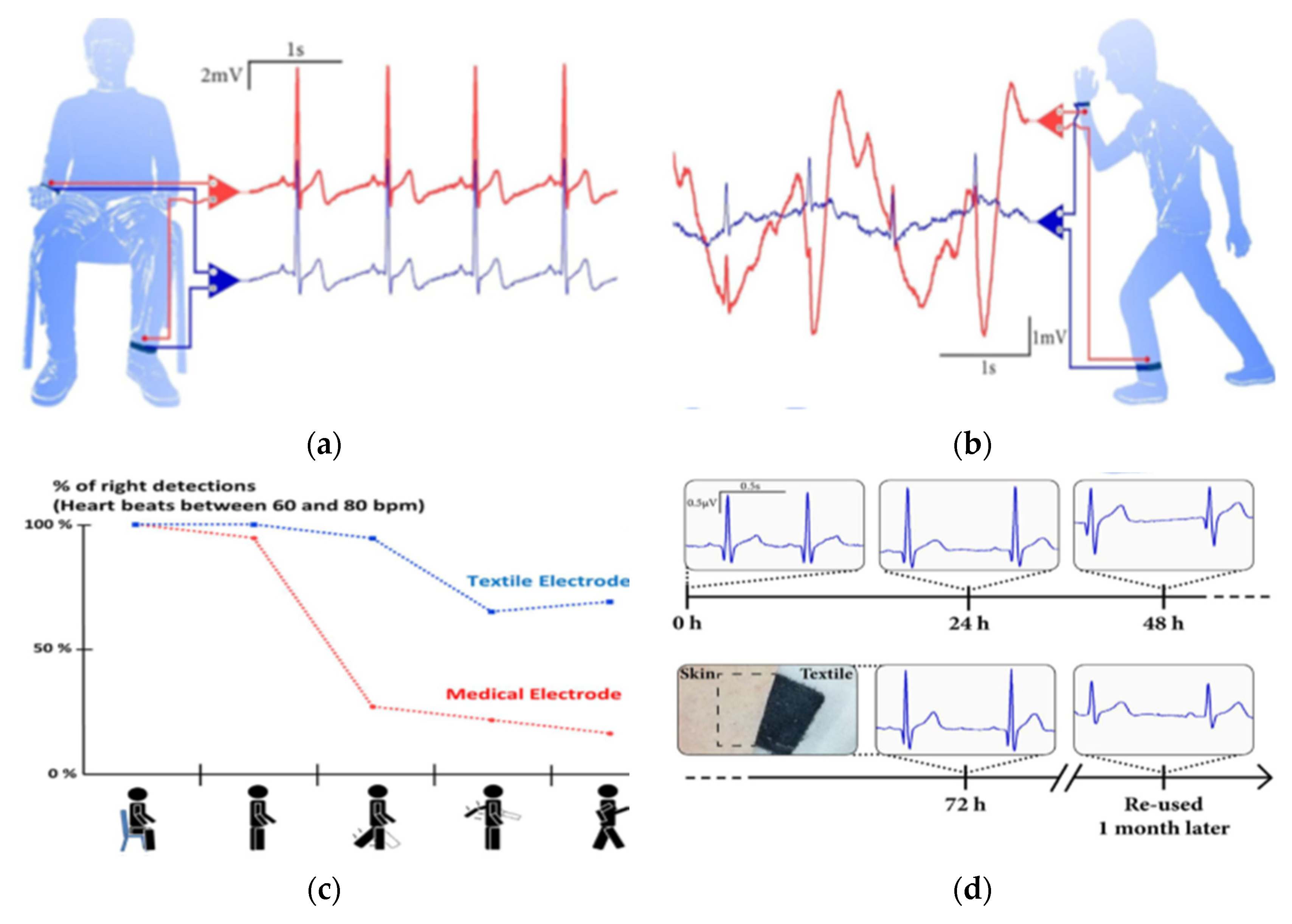
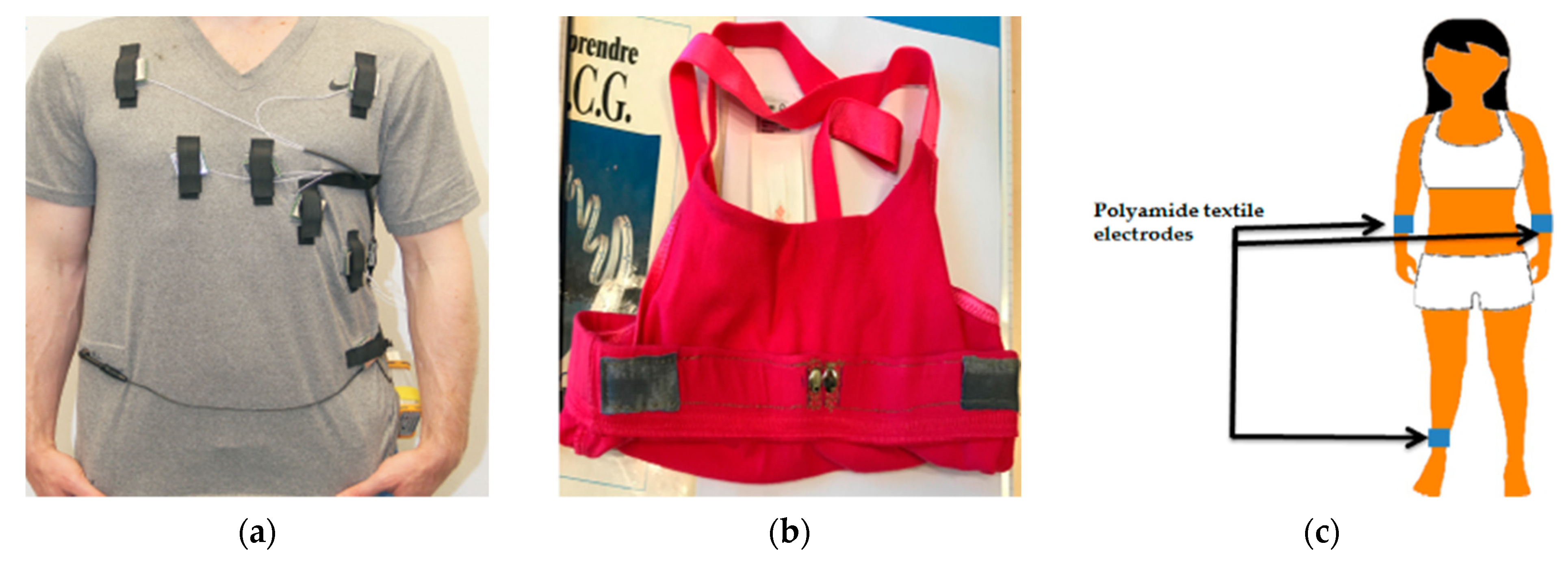
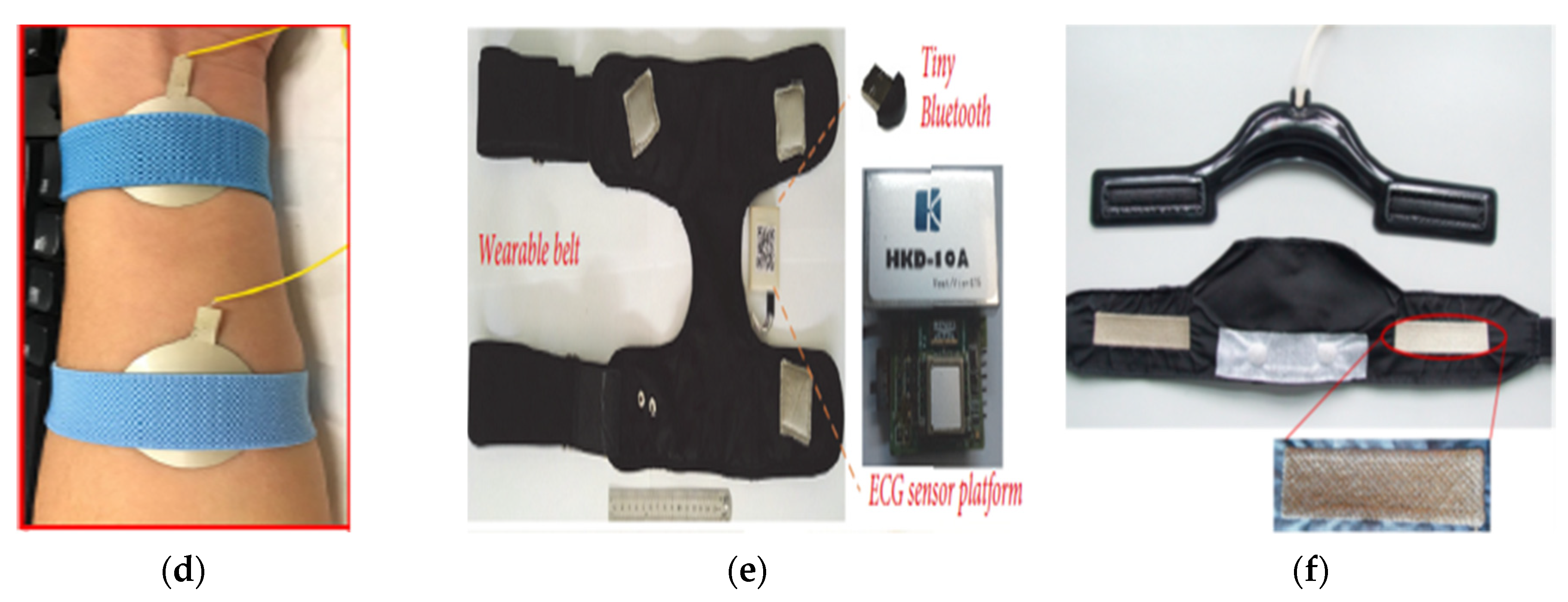
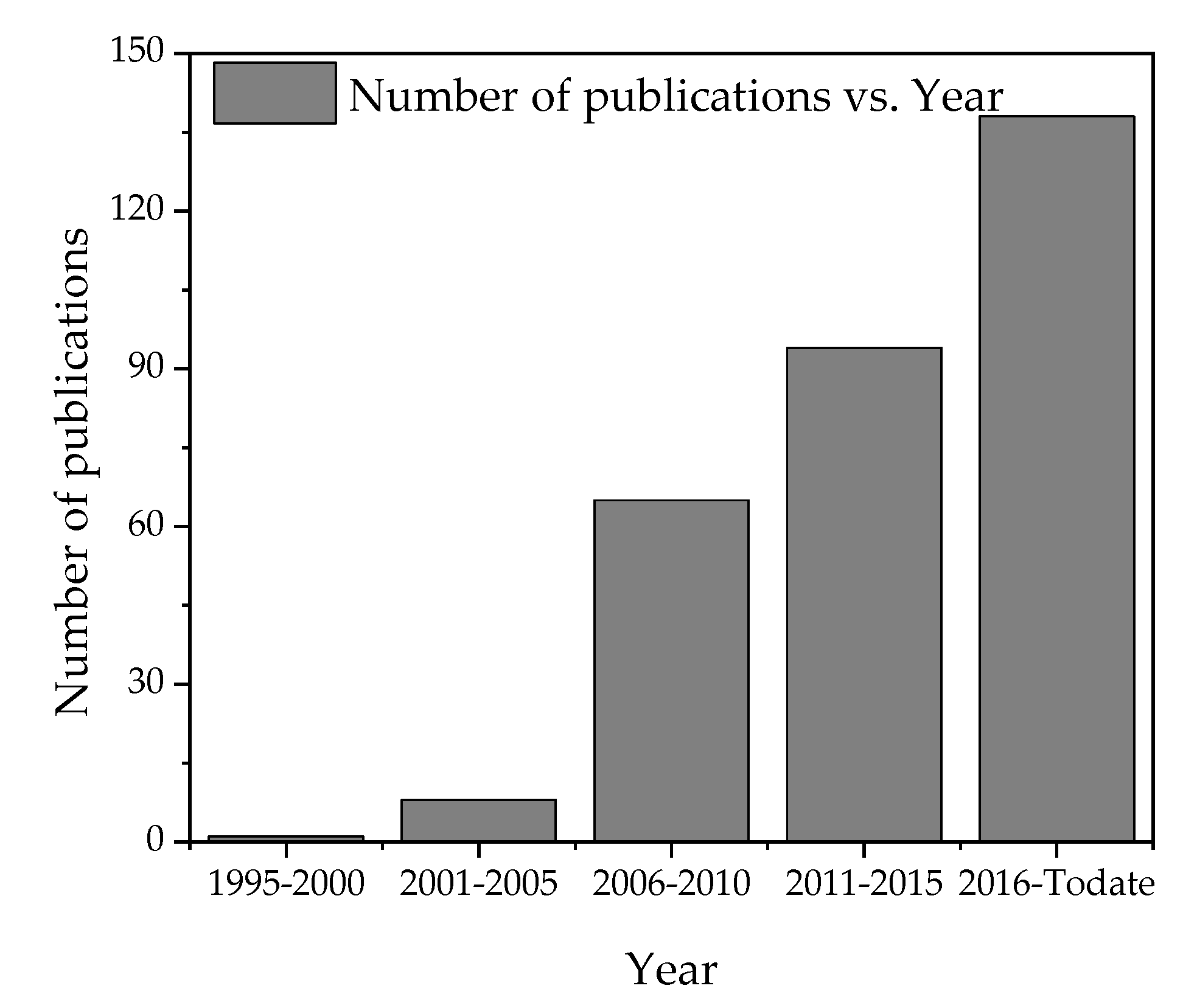
| Integrated in | Materials for Electrodes | Type of Dielectric Material | Location of Measurement | Reference |
|---|---|---|---|---|
| Stretcher, hospital bed, and wheelchair | Silver gel-printed textile | Cotton T-shirt, sweater, and trousers | Backside | [65] |
| T-shirt | Polyamide covered with silver yarn and silver-coated by silver | T-shirt | Two electrodes on the back and a reference electrode at the lower chest | [69] |
| Chest belt | Nickel and copper-coated foam | T-shirt | Lower chest | [67] |
| Mattress and pillow | Nickel and copper-coated conductive foam | Pajama | Back | [71] |
| Neonatal mattress | Conductive textile | Polyurethane | Back | [72] |
| Integrated in | Materials of Electrodes | Sheet Resistance (Ω/sq) | Location of Electrodes | Lead Configuration | Electrode Size (cm2) | References |
|---|---|---|---|---|---|---|
| Vest with Velcro Strap | Nickel/copper-coated foam | 0.07 | Chest | Lead II | 8 | [102] |
| Elastic band | Silver-plated knitted fabric | <100 | Lower chest | Lead I | 8, 4.5, 2.25 | [83] |
| Chest belt | Ag/Ti-coated yarn embroidered into the fabric | NK | Chest | Lead I | 14 | [103] |
| Plastic clamps | PEDOT:PSS screen printed cotton, cotton/lycra | 22.7–117.3 a | Forearms and ground on the ankle | Lead I | 10 | [104] |
| Elastic band | Silver-plated nylon | <1 | Wrist and biceps | NK | NK | [29,105] |
| Elastic band | Polypyrrole-coated cotton | 325 | Forearms and ground on the ankle | NK | 12.25 | [106] |
| Chest belt | Silver-plated nylon | NK | Around abdominal | Lead I | 1, 2, 4, 8, 16 | [107] |
| Adjustable chest strap | Ag/AgCl printed nonwoven fabric | NK | Chest | Lead I | 7.07, 3.14, 0.79 | [108] |
| Chest belt | Silver-plated nylon fabric | NK | Chest | Single lead | 8, 4.5, 2.25 | [81] |
| Chest belts | Silver-plated nylon thread embroidered on polyester fabric | NK | Chest | V3, V4, and V5 lead | 1.21 | [109] |
| Arm strap | Silver and CNT/PDMS-coated PET substrate | NK | Forearms and ground on leg | Lead I | 8.04, 4.5, 2 | [91] |
| T-shirt | Ag/AgCl electro-platted textile | NK | Chest and limbs | 12 Lead | NK | [110] |
| T-shirt | Silver-platted textile | NK | Chest and limbs | 12 Lead | NK | [74] |
| Plastic clamps | PEDOT:PSS-coated polyamide | NK | Forearms and ground on leg | Lead I | 9 | [92] |
| Bedsheet | Silver-plated nylon thread embroidered on a bedsheet | NK | Upper body | NK | 7.04 | [111] |
Publisher’s Note: MDPI stays neutral with regard to jurisdictional claims in published maps and institutional affiliations. |
© 2021 by the authors. Licensee MDPI, Basel, Switzerland. This article is an open access article distributed under the terms and conditions of the Creative Commons Attribution (CC BY) license (https://creativecommons.org/licenses/by/4.0/).
Share and Cite
Nigusse, A.B.; Mengistie, D.A.; Malengier, B.; Tseghai, G.B.; Langenhove, L.V. Wearable Smart Textiles for Long-Term Electrocardiography Monitoring—A Review. Sensors 2021, 21, 4174. https://doi.org/10.3390/s21124174
Nigusse AB, Mengistie DA, Malengier B, Tseghai GB, Langenhove LV. Wearable Smart Textiles for Long-Term Electrocardiography Monitoring—A Review. Sensors. 2021; 21(12):4174. https://doi.org/10.3390/s21124174
Chicago/Turabian StyleNigusse, Abreha Bayrau, Desalegn Alemu Mengistie, Benny Malengier, Granch Berhe Tseghai, and Lieva Van Langenhove. 2021. "Wearable Smart Textiles for Long-Term Electrocardiography Monitoring—A Review" Sensors 21, no. 12: 4174. https://doi.org/10.3390/s21124174
APA StyleNigusse, A. B., Mengistie, D. A., Malengier, B., Tseghai, G. B., & Langenhove, L. V. (2021). Wearable Smart Textiles for Long-Term Electrocardiography Monitoring—A Review. Sensors, 21(12), 4174. https://doi.org/10.3390/s21124174









